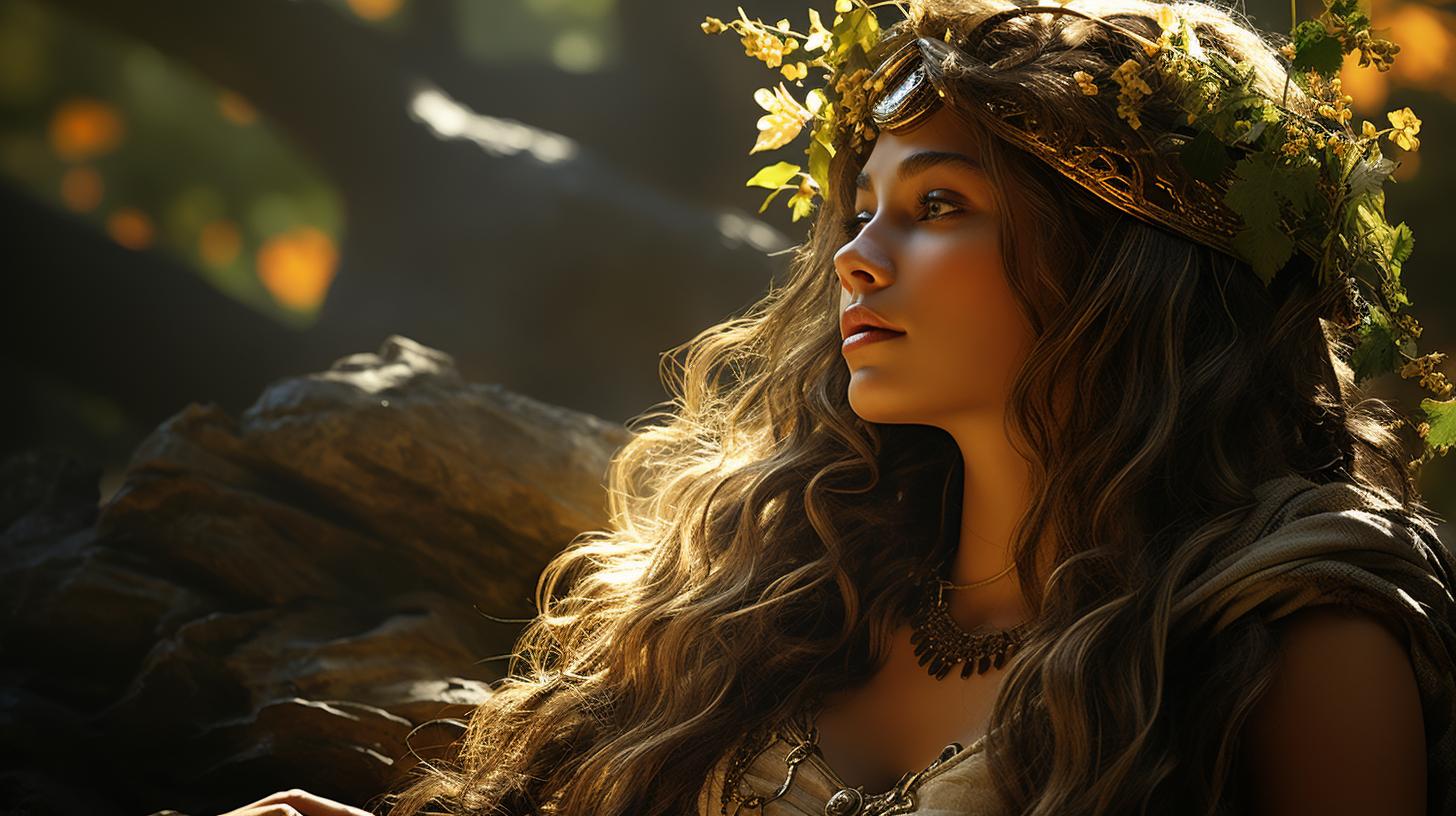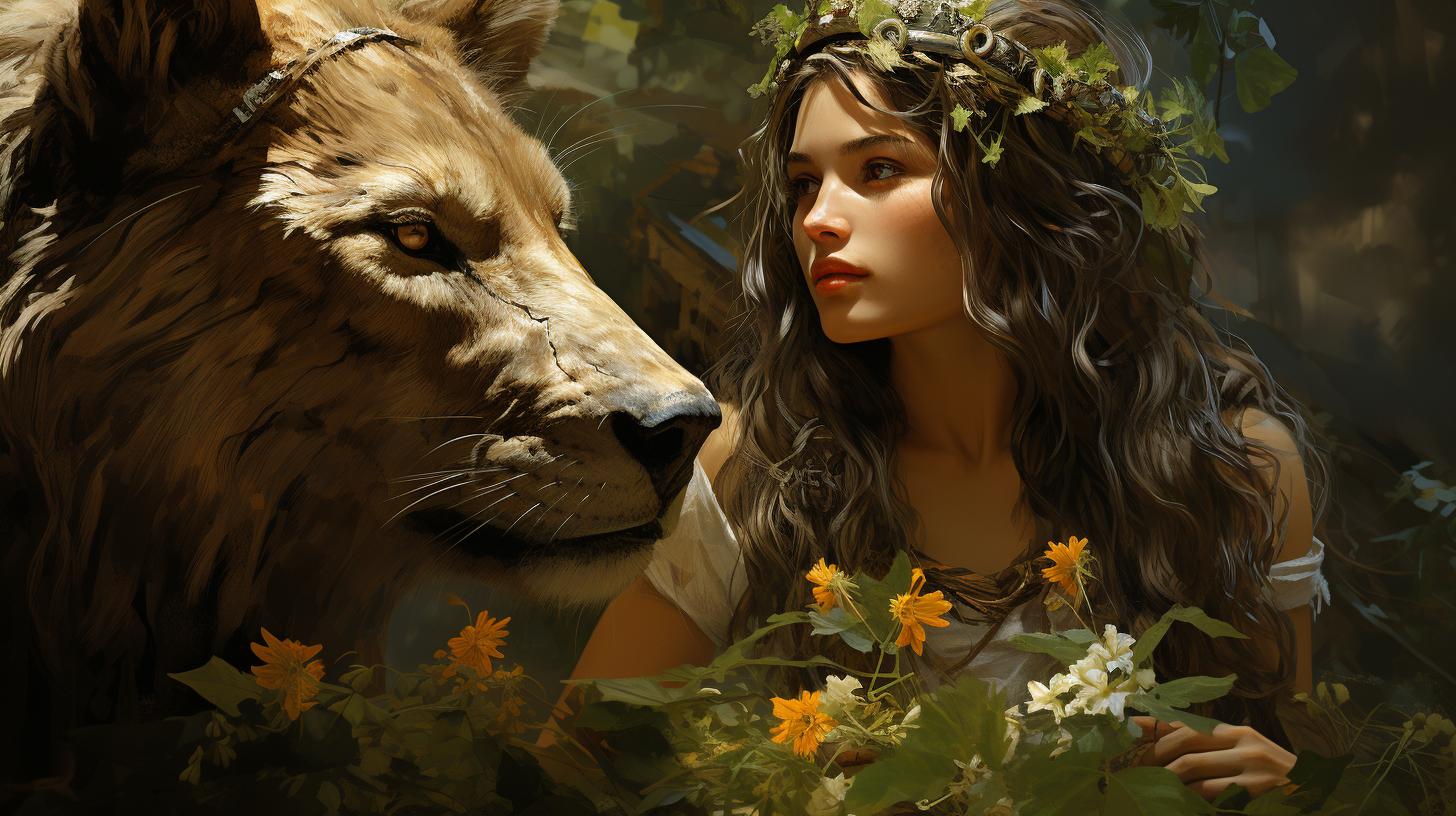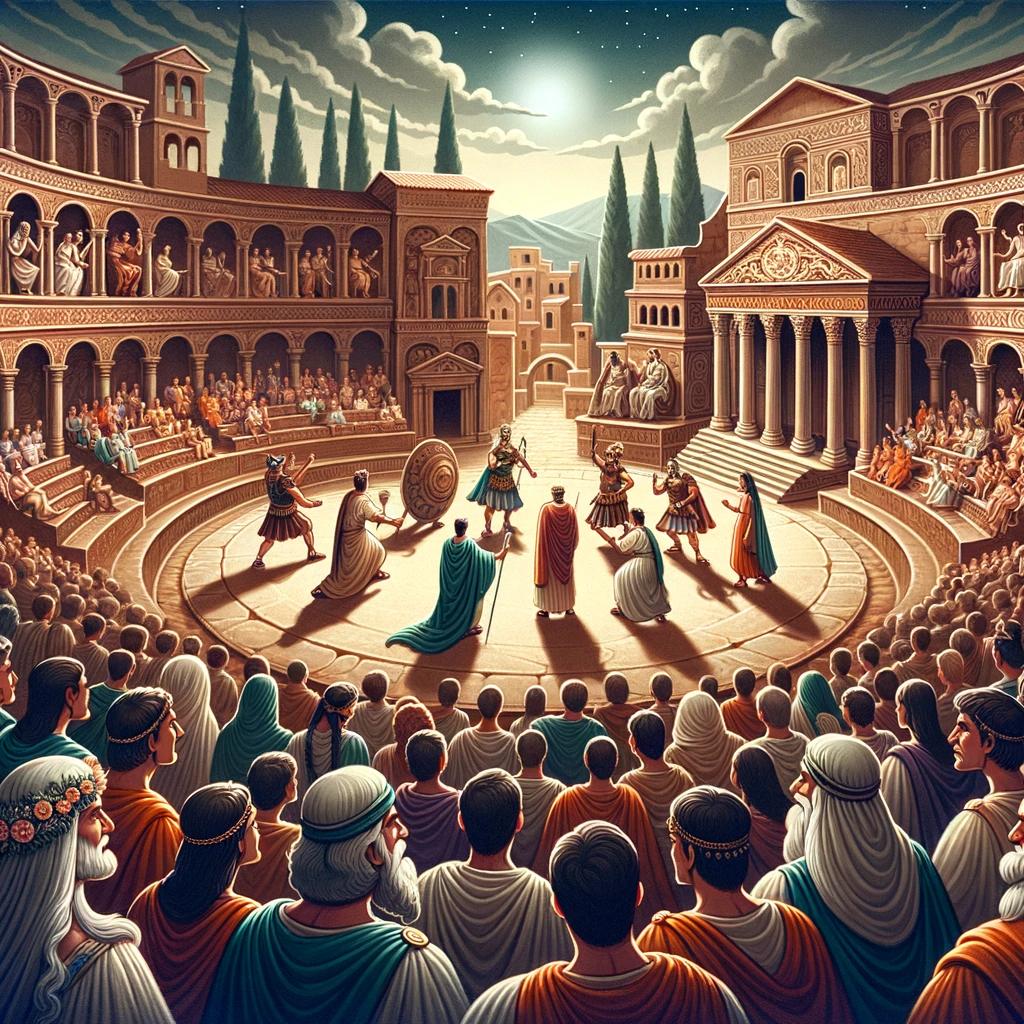Feronia Goddess: Exploring the Wild and Liberating Essence of the Ancient Roman Deity

Feronia goddess, a deity revered in ancient Roman religion, holds significant associations with wildlife, fertility, health, and abundance. Honored by plebeians and freedmen, she was believed to grant freedom and civil rights to society’s humblest members.
Feronia’s cult encompassed various interpretations, including her role as a harvest goddess or a deity of travelers, fire, and waters. Her connection to freedom and liberty led to her association with the goddess Libertas.
With sanctuaries located in wild places, Feronia’s influence extended throughout central and northern Italy, as well as Sardinia and the northeast.
The Mythology and Origins of Feronia Goddess
Feronia, a revered goddess in ancient Roman religion, has a rich mythology intertwined with her origins. Let’s delve into the fascinating history of Feronia, exploring the Etruscan and Sabine religion, her adoption into the ancient Roman pantheon, and the significance of her association with wildlife and the untamed wilderness.
The Etruscan and Sabine Religion
Before Feronia became a prominent figure in Roman mythology, she was worshipped by the Etruscans and Sabines. These ancient civilizations revered her as a deity of fertility, health, and abundance.
Feronia held a special place in their religious practices, and sanctuaries dedicated to her were often situated in untamed, wild places, reflecting her connection to the wilderness.
Adoption into Ancient Roman Religion
As the power of ancient Rome expanded, so did the incorporation of local deities into their pantheon. Feronia was no exception. The Romans recognized her significance and began to venerate her alongside their own gods and goddesses.
She found a special place among the plebeians and freedmen of Roman society, who believed in her ability to grant freedom and civil rights to the humblest members of society.
The Significance of Feronia’s Association with Wildlife and Wilderness
One of the notable aspects of Feronia’s mythology is her association with wildlife and the untamed wilderness. The name “Feronia” itself derives from a Sabine adjective meaning “not cultivated, untamed,” which perfectly encapsulates her link to the wild.
Her sanctuaries were often located in remote, natural settings, emphasizing her connection to the untamed forces of nature. Through her association with wildlife and the wilderness, Feronia embodied the primal and primal forces that governed the natural world.
Feronia’s Role in Roman Society
Feronia, the ancient Roman goddess, played a significant role in the society of that time. Worship among plebeians and freedmen, freedom and civil rights, and festivals and celebrations were all aspects associated with the veneration of Feronia.
Worship Among Plebeians and Freedmen
Feronia held a special place of honor among the plebeians and freedmen of Roman society. She was seen as a benefactor and was believed to grant freedom to slaves or civil rights to the most humble members of society.
Her cult attracted a devoted following from those seeking liberation and better opportunities.
Freedom and Civil Rights
The association of Feronia with freedom and civil rights further underscored her significance in Roman society. Her cult was especially embraced by those who sought social progress and equality. Many believed that by paying tribute to Feronia, they could secure blessings of liberty and a better future for themselves and their families.
Festivals and Celebrations
The festivals dedicated to Feronia, known as the Feroniae, held a prominent place in the Roman calendar. Celebrated during the Ludi Plebeii on November 13, these festivities were marked by joyous gatherings, processions, and various rituals.
The celebrations were an occasion for the community to come together, express their gratitude to Feronia, and seek her blessings for abundance and well-being.
Exploring the Various Interpretations of Feronia
As we delve deeper into the realm of Feronia goddess, we encounter a multitude of interpretations that surround her divine essence. Let us embark on a journey into the diverse facets that have shaped the understanding of this revered deity.
Harvest Goddess or Goddess of Travellers?
One interpretation of Feronia portrays her as a bountiful harvest goddess, bestowing fertility and abundance upon the land. With her association with wildlife and wilderness, Feronia’s connection to the cyclic rhythms of nature and the fruitful harvests that sustain civilizations becomes apparent.
However, another perspective sees Feronia as a deity of travelers, guiding and protecting those venturing across vast landscapes. With sanctuaries situated in wild and untamed places, it is believed that Feronia offered solace and safe passage to weary wanderers.
Feronia as a Goddess of Fire and Waters
Expanding our exploration, Feronia’s realm extends to the elements of fire and waters. She is revered as a deity with the power to ignite the flame of transformation and renewal. In ancient rituals, fire was seen as a purifying force, and Feronia’s association with it reflects her role in guiding spiritual growth and rebirth.
Moreover, Feronia’s affiliation with waters signifies her connection to the life-giving force that flows through rivers, streams, and sacred springs. This elemental aspect adds depth to her character, highlighting her role as a nurturer and sustainer of life.
The Association with Freedom and Liberty
One of the most profound interpretations of Feronia goddess is her association with freedom and liberty. This concept aligns with her veneration by plebeians and freedmen, as she was believed to grant freedom to slaves or bestow civil rights upon the most humble members of society.
Feronia’s connection to the goddess Libertas further strengthens this association, as both deities embody the emancipation from bondage and the pursuit of personal autonomy. Through her worship, individuals sought liberation from physical and societal constraints, finding empowerment and liberation in the divine presence of Feronia.
Feronia and her Connection to Other Deities
Feronia, the ancient Roman goddess, had significant associations with other deities, contributing to her multifaceted nature and importance in Roman beliefs and rituals.
Association with Libertas and Other Goddesses
Feronia was closely linked with the goddess Libertas, who symbolized freedom and liberty in Roman mythology. This association emphasized Feronia’s role in granting freedom and civil rights, particularly among the lower classes of society.
Furthermore, Feronia’s divine presence intertwined with other goddesses, each representing different aspects of nature and divine power. These associations highlighted Feronia’s broad influence in various realms and reinforced her significance within Roman religious practices.
Feronia in Vergil’s Aeneid
The works of the Roman poet Vergil further solidified Feronia’s place in mythological narratives. In his epic poem, the Aeneid, Feronia’s troops fought alongside Turnus against Aeneas, showcasing her involvement in important mythological conflicts.
The Arcadian king Evander recounts his encounters with Feronia, including his triumphant battles against her son Erulus, who met his demise multiple times. This depiction exemplifies Feronia’s presence in mythological tales and her connections with renowned figures in Roman literature.
In conclusion, Feronia’s connections with other deities, such as Libertas, and her inclusion in mythological narratives, as seen in Vergil’s Aeneid, contributed to her significance within Roman society and solidified her role as a revered goddess.
Feronia’s Cult and Sanctuaries
The cult of Feronia, the ancient Roman goddess, was deeply rooted in the beliefs and practices of the people. Her sanctuaries held great significance and were revered as sacred spaces where miracles were believed to occur.
Terracina: The Sacred Temple and Miraculous Events
One of the most prominent sanctuaries dedicated to Feronia was located in Terracina. This sacred temple was a place of worship and devotion, attracting pilgrims from far and wide. It was here that a remarkable event took place – a fire ravaged the wooden structures of the temple, but miraculously, the burnt remains turned green, symbolizing the regenerative power associated with Feronia.
Sabines and Feronia’s Image on Coins
The Sabines, an ancient Italic tribe, held Feronia in high regard and revered her as a significant deity. They even depicted her image on their coins, emphasizing her importance and influence in their society.
Feronia’s Shrines in Central Italy and Rome’s Campus Martius
Feronia’s presence extended throughout central Italy, and her shrines were found in various locations within the region. People would visit these sanctuaries to offer their prayers and seek her blessings. In Rome’s Campus Martius, a prominent area of the city, Feronia’s temple stood, serving as a testament to her worship in the heart of the Roman Empire.
In conclusion, Feronia’s cult and sanctuaries held immense significance in ancient Roman society. Terracina, with its sacred temple and miraculous events, was a focal point of devotion. The Sabines honored Feronia by featuring her image on their coins, while shrines dedicated to her dotted central Italy and even the bustling city of Rome.
This rich tapestry of worship and reverence exemplifies the deep-rooted connection between Feronia and the people of ancient Rome.
Feronia’s Attributes and Worship
Feronia, the ancient Roman goddess, possessed a multitude of attributes and was revered through various forms of worship. Let’s explore two key aspects of her worship – fertility, abundance, and her shamanic role, as well as the offerings, rituals, and practices associated with her devotion.
Fertility, Abundance, and the Shamanic Role
Feronia was widely recognized as a goddess associated with fertility and abundance. She was believed to bless the land with bountiful harvests and ensure the prosperity of agricultural endeavors. Her connection to the wild and untamed symbolized the untapped potential and abundance found in nature.
Moreover, Feronia played a significant shamanic role in ancient Roman culture. As a mediatory deity, she facilitated communication between different realms and acted as a conduit for spiritual experiences.
Her devotees sought her guidance and assistance in navigating the mysteries of life, as well as in connecting with the spiritual energies of the natural world.
Offerings, Rituals, and Practices
Devotees of Feronia honored her through a range of offerings, rituals, and practices. They presented her with offerings of fruits, grains, and other agricultural produce, acknowledging her role as a fertility deity.
These offerings were often made in sanctuaries located in wild and natural settings, reflecting her association with the wilderness.
Rituals dedicated to Feronia involved both communal and individual acts of worship. Celebrations, ceremonies, and processions were organized to honor and express gratitude to the goddess. These gatherings brought communities together, fostering a sense of unity and collective well-being.
Individual practices included seeking spiritual guidance from Feronia through prayers, meditations, and personal offerings. Some rituals involved purification rites, symbolizing the cleansing of both the physical and spiritual aspects of one’s being.
These practices aimed to establish a deeper connection with Feronia and invoke her blessings and protection.
- Celebration of Feronia’s fertility and abundance through offerings of fruits, grains, and agricultural produce.
- Communal rituals, ceremonies, and processions dedicated to Feronia.
- Individual practices like prayers, meditations, and personal offerings to seek spiritual guidance.
- Purification rites to cleanse the physical and spiritual self.
Through the worship of Feronia, ancient Romans honored her attributes of fertility, abundance, and shamanic power.
They engaged in offerings, rituals, and practices that sought to establish a profound connection with the goddess and tap into the richness of the natural world she embodied.
Feronia Goddess in Modern Context
Feronia’s influence continues to resonate in central and northern Italy, where her ancient cult left a lasting legacy.
Today, her presence can still be found in various aspects of Italian culture and heritage.
Continuing Influence in Central and Northern Italy
In central and northern Italy, Feronia’s worship and mythology have endured, ingrained in the region’s folklore and traditions. Her connection to fertility and abundance is reflected in agricultural practices, with rituals and celebrations dedicated to ensuring fruitful harvests.
Furthermore, Feronia’s association with wildlife and the wilderness is celebrated through nature conservation efforts and the preservation of natural habitats. Her spirit remains a guiding force in promoting environmental awareness and protecting the diverse flora and fauna that inhabit the region.
Connection to Italian Culture and Heritage
Feronia’s role in ancient Roman society has left an indelible mark on Italian culture and heritage. She is often referenced in literature, art, and architectural motifs, serving as a symbol of liberation and freedom.
Her mythological significance is also evident in local festivals, where communities come together to honor and pay homage to Feronia. These vibrant celebrations showcase traditional music, dance, and customs deeply rooted in the region’s history.
Exploring Further: Feronia in Literature and Art
Feronia’s intriguing presence in ancient texts and depictions in various forms of art provide a deeper understanding of her significance in Roman culture. Mentioned in well-known ancient texts and valued by Roman philosophers, Feronia’s name resonated within the realm of mythology and religion.
Mention of Feronia in Ancient Texts and Roman Philosophers
References to Feronia can be found in literary works such as Vergil’s Aeneid, where she is depicted as a deity involved in warfare, fighting on the side of Turnus against Aeneas.
The Arcadian king Evander recalls his encounter with Feronia’s son, Erulus, highlighting her mythical lineage. These accounts provide a glimpse into the captivating narratives surrounding Feronia’s existence.
Feronia also caught the attention of Roman philosophers, including Varro, who recognized her as a tutelary goddess of freedmen.
The temple near Terracina became a significant site for setting slaves free, and Feronia’s association with freedom and liberation echoed in the philosophical discourse of the time.
Depictions of Feronia in Art and Sculptures
The artistic representation of Feronia offers visual insights into her divine attributes and revered presence.
Sculptures and statues often portrayed her with symbols of fertility, such as grains and fruits, showcasing her association with abundance. Her connection to the wilderness is depicted through imagery of untamed landscapes and wild animals accompanying her.
Artists captured Feronia’s essence through intricate details, reflecting her multifaceted nature. Some sculptures portrayed her as a serene harvest goddess, radiating tranquility and prosperity. Others depicted her as a powerful guardian of travelers, emanating strength and protection.
The artistic depictions of Feronia not only served as religious iconography but also influenced Roman society’s perception and understanding of her various roles and attributes.
- References to Feronia in ancient texts highlight her involvement in epic narratives and mythological accounts.
- Roman philosophers recognized Feronia as a tutelary goddess of freedmen, emphasizing her connection to freedom and civil rights.
- Artistic representations in sculptures and statues depict Feronia’s association with abundance, fertility, and the wild.
- Depictions capture her serenity as a harvest goddess and her strength as a guardian of travelers.
Exploring Feronia in literature and art adds further layers to understanding her role and significance in ancient Roman culture.
.




















